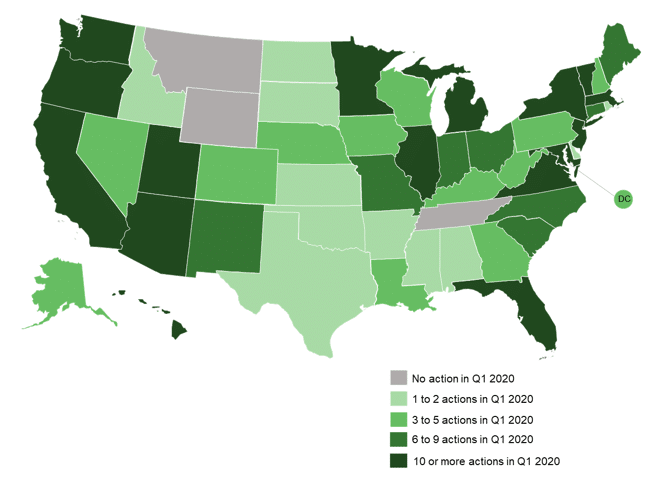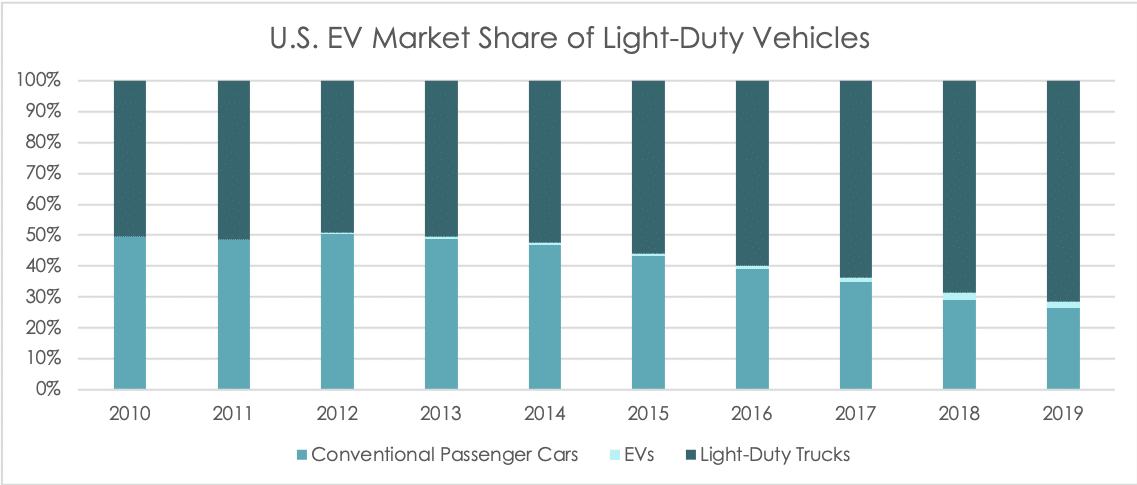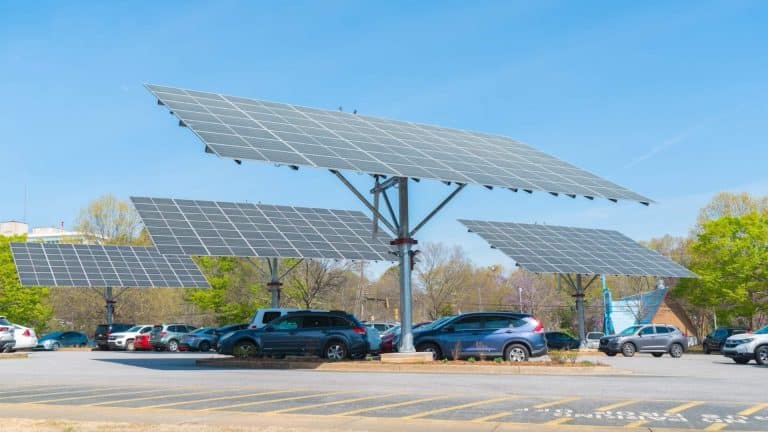No matter who we are or where we are, the impacts of COVID-19 challenge us to keep ourselves, our families, and our communities safe and financially secure. In the wake of this challenge, we have the opportunity to rebuild our economy to ensure a healthy and prosperous future. This is a once in a lifetime opportunity that we owe it to ourselves to seize.
Transportation sector is ripe for remaking
Our nation’s transportation provides world-class mobility of people, goods, and services. But because transportation relies so heavily on gas and diesel-powered cars and trucks, it creates significant problems, including exposure to the oil market volatility, and ground-level air pollution, which disproportionately impacts the health of vulnerable populations. However, we are not obligated to maintain this system forever. We have the technology and resources to enhance the quality of American transportation and address public health, energy security, and climate change.
Electric vehicle (EV) market has traction
The most viable option on the table is a full-scale automotive transition from internal combustion to electric vehicles:
- In 2020 we have, for the first time, more new model EVs entering the market than we do new model gas cars.
- The cost of EVs is coming down as battery prices drop from approximately $300 a kilowatt-hour (kWh) in 2015 to just over $100kWh in 2020. When battery prices hit $100/kWh, the higher upfront cost of an EV compared to comparable gas car vanishes.
- The driving range of base-level EVs is now over 200-miles, and the public charging infrastructure needed to keep them moving is steadily increasing, thus eliminating two of the biggest barriers to mass-market adoption: limited range and lack of adequate charging stations
- There are now light, medium, and heavy-duty EVs available, including a rapidly expanding transit and school bus market.
- In the first 3 months of 2020, all but three states adopted policies to accelerate EV market momentum.
Q1 2020 State and Utility Action on Electric Vehicles

Even considering the multitude of benefits we can realize by switching from gas guzzlers to EVs, it will take more than a one-for-one swap to accelerate our economic recovery, improve public health, strengthen national security, and tackle climate change. We need a holistic strategy to reduce, clean, and electrify transportation.
REDUCE the Number of Vehicle Miles Traveled
There are over 273,000,000 registered motor vehicles in the U.S. traveling 3.3 trillion miles annually fueled by 145 billion gallons of gasoline. Reducing these numbers is the most effective way to reduce oil dependency, emissions, and congestion. Most of us are seeing these impacts right now as we comply with stay-at-home orders. Companies, cities, states, and the federal government can adopt strategies to support reduced vehicle use, such as increasing mobility choices, building housing near jobs and services, and providing economic incentives.
To support both a reduction in vehicle miles traveled AND an increase in EVs, we should focus EV goals on the percentage of new car sales rather than the number of EVs sold. This is an important nuance that eliminates the conflict between adding more EVs to America’s automobile fleet and decreasing the amount Americans drive. We can succeed at both at the same time.

In 2019, EVs reached 2% of new car sales. The challenge is to rapidly increase the percentage of EVs sold while decreasing the overall number of personal vehicles sold.
CLEAN the Electric Utility Grid
Electric vehicles plug into the electric utility grid. Thus, the cleaner the electricity, the cleaner the EV. In the U.S. today, the average emissions from driving an EV are equivalent to driving a car that gets 88 miles per gallon. How electricity is generated varies state by state. In New York where a lot of renewable energy has been deployed, driving an EV is like driving a car that gets 231 miles per gallon!
We have the technology today to begin transitioning the nation’s utility mix to 100% renewables. For example, advancements in utility-scale solar paired with battery storage have brought costs below both coal and natural gas. That means that in most cases, the cheapest new source of power production is solar + battery storage.
As our aging coal plants are retired, we should seek every opportunity to replace the needed generation with renewables. In a business-as-usual scenario, renewable energy is expected to become the largest source of power generation in the U.S. by 2050. With strategic investments and smart energy policy, we can get more emission-free clean energy sooner.
ELECTRIFY Transportation
Why electrify transportation? Because EV benefits are significant:
- Cost: EVs are 2.3 times cheaper to operate than gas-powered vehicles in large part because they are very low-maintenance.
- Public Health: EVs have no tailpipe and no tailpipe emissions, which is significant given that 4 out of 10 Americans live in counties already experiencing unhealthy levels of air pollution, much of it caused by auto emissions.
- Security: America’s regulated electricity sector is a source of homegrown energy not prone to volatility and geopolitical instability like global oil markets.
- Climate: EVs already reduce auto greenhouse gas emissions by upwards of 70%, and will reduce more each day as the grid gets cleaner.
As we look for opportunities to rebuild our economy as we come out of COVID-19 induced social and economic hibernation, electrifying transportation is a powerful tool. By electrifying transportation, and at the same time transitioning to clean energy, we can unleash the innovation and job creation potential of two of the nation’s largest and most important sectors. Add aggressive investments in transit and urban design to reduce auto dependency will maximize long-term public health, energy security, economic development, and climate benefits.
The Southern Alliance for Clean Energy’s Electrify the South campaign advocates for a shift to clean, electric transportation throughout the Southeast. Visit Electrify the South.org to learn more and connect with us.



